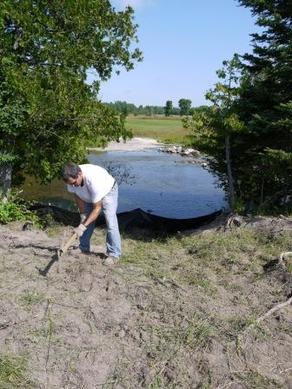Manitou River - M-38

Site M38 on the Manitou River required improving the riparian vegetation, improving tree canopy and bank stabilization. Volunteers, landowners and Manitoulin Streams planted trees and shrubs in former livestock crossing areas to prevent further erosion as well as provide shade and food sources for invertebrates and a variety of fish species. One particular livestock crossing needed to be restored to a more natural state. The crossing area was highly eroded and lacked any significant vegetation to allow it to repair itself. Soil from the property was used to back fill the large “v” erosion then covered with top soil, a layer of hay, a layer of coir erosion control blanket and then another small layer of soil, seeded then planted with trees and shrubs. This whole effort was undertaken without the use of machinery except for the delivery of top soil and hay using trucks and trailers.
The rehabilitation of the M38 Manitou River involved tree/shrub planting in a 588 sq metre area of shoreline & wetland protected, stabilized improved and/or retired, 42m sq of shoreline protected, stabilized improved, 4 m2 top soil, 42 sq m of native grass seed applied, 1000 tree plugs planted.
This project had 7 volunteers from the Board of Directors of Manitoulin Streams participate in planning and actively volunteering at rehabilitation sites. The total number of hours volunteered for this site is 51.4. A total of 8 other volunteers contributed 105 hours mainly by tree planting and conducting field work. The landowner contributed 16 hrs of labour and 3 hrs of attending meetings and materials off the property.
Funding contributions toward the construction of the project include CFWIP and NOHFC.
The rehabilitation of the M38 Manitou River involved tree/shrub planting in a 588 sq metre area of shoreline & wetland protected, stabilized improved and/or retired, 42m sq of shoreline protected, stabilized improved, 4 m2 top soil, 42 sq m of native grass seed applied, 1000 tree plugs planted.
This project had 7 volunteers from the Board of Directors of Manitoulin Streams participate in planning and actively volunteering at rehabilitation sites. The total number of hours volunteered for this site is 51.4. A total of 8 other volunteers contributed 105 hours mainly by tree planting and conducting field work. The landowner contributed 16 hrs of labour and 3 hrs of attending meetings and materials off the property.
Funding contributions toward the construction of the project include CFWIP and NOHFC.

